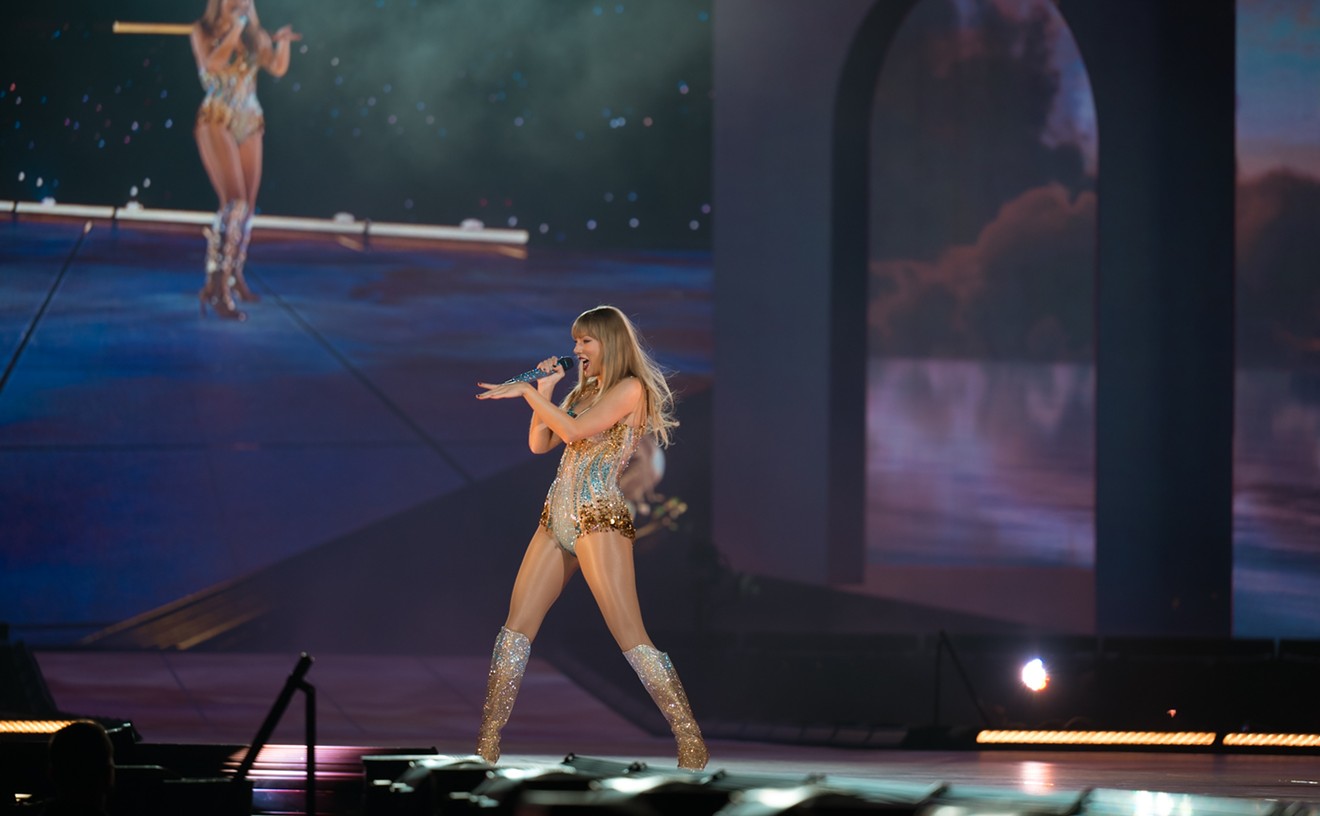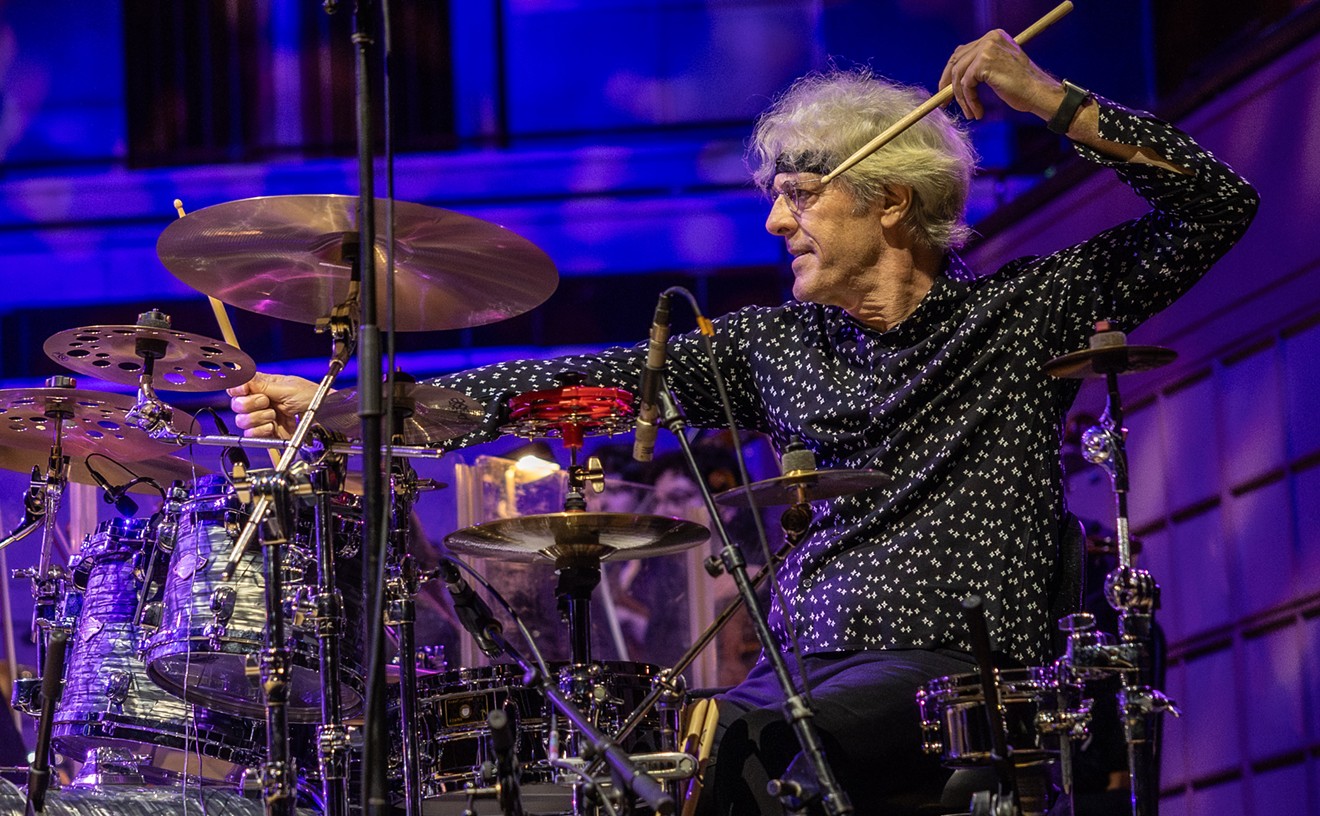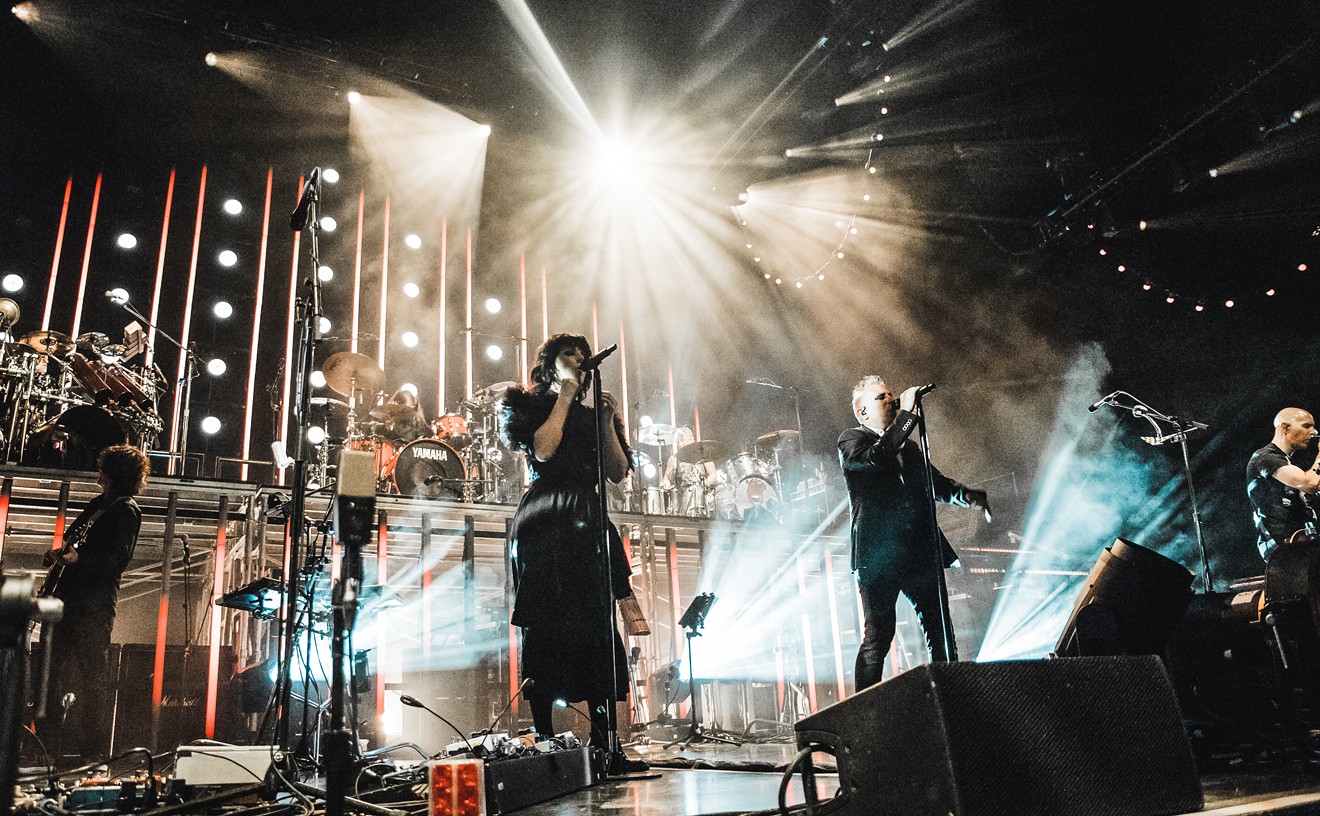On the drive up Interstate 35, Oklahoma City radio station KRXO (107.7 FM) had whipped itself into an entirely un-ironic froth over the show, with DJs gushing "The Stones! In Norman! Whooda thunk it! Rock! On!" in between Led Zep; Foreigner; and Emerson, Lake and Palmer songs. So great was their delight and apparent surprise that you might have imagined Norman a leper colony, the recipient of a recent B-52 carpet-bombing raid, or both. Instead, Norman is a cleanly scrubbed college town full of boisterous Sooners prone to much "Whoooo"-ing and holding aloft of beer cans. Owen Field, a traditional college stadium, sits at the edge of the University of Oklahoma campus. That night it looked like a cauldron, with a thick, dirty-white mist--equal parts breath-vapor and various smokes and exhausts--boiling out of the top. For a second, a bit of the old creepiness, the dark power, of the Stones asserted itself. It was soon lost, however, among a general carnival atmosphere: Thousands without tickets milled about the venue, ruddy-cheeked in the cold and swilling 3.2 beer; surrounding dorms had their windows and porch doors thrown open, the better to hear the show. There was a definite sense that not many morning classes would be attended the next day.
The show at the Speedway, however, was quite a bit different. The sense of an impending event was swallowed whole by the immensity of the raceway complex. Sitting in the middle of nowhere, surrounded by acres of parking, the grandstands and support buildings for the track were huge, like the assembly plants for jetliners or Saturn V rockets. The traffic trickling in around 5 p.m. was swallowed by the asphalt-and-grass expanse allotted for parking; even at the end of the show, close in to the track itself there were dozens of unfilled spots.
The stage itself--which had seemed suitably mammoth at Owen Field, its gilded superstructure and giant inflatable female statuary recalling D.W. Griffith's Intolerance--was dwarfed by the hundreds of yards of empty seating that stretched away on either side like gray concrete wings. In back of the stage, far off in the distance, the stands on the other side of the racetrack could dimly be seen. Mara, a lucky record-store employee from Missouri who received complimentary tickets and was invited to meet the band, reported that the distance between the "backstage" area and the stage was more than a mile; she also said that Mick Jagger was the only band member who didn't shake the hands of those civilians who got to meet 'n' greet the Stones.
The two shows had certain similarities. Both started--as have most of the shows on the tour so far--with the quintet of "Satisfaction," "It's Only Rock 'n' Roll," "Let's Spend the Night Together," "Flip the Switch" (off the new album), and "Gimme Shelter." Jagger then strapped on an acoustic guitar and slowed things down a bit--in Norman with "Sister Morphine" and in DFW with "Dead Flowers." The next group of songs is where the band chose to mix up the set list; throughout the North American leg of the tour so far you could count on hearing "Has Anybody Seen My Baby" and "Out of Control," the other songs off the new album that are getting live play, as well as "Miss You" and Keith Richards' "Wanna Hold You," usually preceded by his "All About You." The other songs featured "19th Nervous Breakdown" and the gospel-tinged "Shine A Light" (Norman), "Bitch" (DFW and the in-between show in Albuquerque on October 30) as well as a surprising Speedway appearance of "Star, Star." Other earlier venues saw versions of "Ruby Tuesday," "Memory Motel," "Rock and a Hard Place," or "Factory Girl" in this spot.
Then it was time for the giant walkway to extend from beneath the main stage, slowly reaching the small, club-sized stage that rose to meet it, located well out amid the floor seating. The Stones, led by Charlie Watts, then strode across it and played a brief "club set" that harkened back to their roots: Chuck Berry's "Little Queenie," "Crazy Mamma" (or "Last Time" in Norman), and "You Got Me Rockin.'" The smaller stage was a nice touch, a way to bring the band closer to the folks in the back. The idea worked better at the Speedway--where the seating was relatively shallow but stretched along the sides of the main stage--than it did at Owen Field, where the football field layout meant that the crowd was confined to a fairly narrow band that went back quite a way. Regardless of how the audience was arrayed, however, it gave many a much closer look at their heroes than they had expected--especially when the band walked back through the crowd on their way to the main stage--and generated a small sense of something that previous Stones tours have been almost devoid of: intimacy.
The next and final part of the show, back on the main stage, was fairly standard and pretty much the same regardless of venue: "Sympathy for the Devil," "Tumblin' Dice," "Honky-Tonk Women," and "Jumpin' Jack Flash," and "Start Me Up," with an encore of "Brown Sugar." Another unifying theme was the band's relentless self-marketing: shills stood outside the venues, passing out brochures for the Official Rolling Stones Visa or MasterCard--"the card with attitude" and no clearly defined interest rate. If you didn't bring enough green for a $10 fridge magnet, a $35 Bridges to Babylon T- shirt, a $60 '72 tour blanket, a $100 denim jacket, a truly hideous $150 mouth-and-tongue table lamp, or a $350 leather jacket, fear not--others were standing by, hopping from one foot to the other in the evening chill and passing out mail-order catalogs.
The folks at the Speedway have a lot to learn about rock 'n' roll crowd control. Our party walked through our gate without ever having our tickets torn, touched, or even looked at; tickets were likewise irrelevant to gaining access to whatever section you were sitting in. This meant that there were whole squadrons of interlopers on every row that had to be notified, argued with, and sent packing before you could sit down; on their way out, they had to walk over folks already seated and past others who were trying to take their seats. This quickly led to foot-traffic jams, which, combined with the large numbers of people hanging out in aisles and on steps and landings, made getting around a full-contact, shoulder-out, head-down exercise more appropriate for linebackers than for folks spending hundreds of dollars on an evening of fun.
The crowds at Owen Field and at the Speedway were a bit different in the ways you'd expect: Norman had the younger crowd, rowdier and more exuberant, while the Speedway seemed to hold the whole variegated race of rock fans within its mammoth oval: parents and kids happily sharing the concert experience and vodka-impaired troglodytes who drove in from Amarillo and could hardly speak beneath a sour-smelling shout or stand up. There was a guy in a battered cowboy hat with a beard, a new black eye and a cut on his cheek, bikers in their leathers, college kids from Austin, skanky-looking skate punks from Highland Park and Haltom City--everybody was flying their flag, declaring who they were even as they came together as a bigger whole. One long-tressed dude in wrap-around shades was even there in his kilt, no doubt still waiting for Axl to send him that return ticket from Paradise City.
There was a palpable sizzle in the air at both venues, a spark that drew power from expectation: The Rolling Stones. Live, here, tonight. I'll tell all my friends about it tomorrow and everyone at work on Monday, and later I may even tell my kids. For the most part, the Stones--despite the overall roughness of their performance (both venues saw an abundance of flubbed notes and mis-cues) and the general impression that they're a bunch of jet-setters who have to re-familiarize themselves with their music every couple of years--rewarded that excitement.
The band knows to surround themselves with talent: a four-piece horn section led by the great Bobby Keyes on tenor sax, Darryl Jones on bass, former Allman Brother Chuck Leavell on keyboards, and three top-notch backup singers: Blondie Chaplin; Bernard Fowler, who has worked with Richards, Watts, and Ron Wood on their solo projects; and Lisa Fisher, who does a star turn on "Gimme Shelter" every bit the equal of the original and brought the house down both times. On drums, Watts has the same bemused dignity that he's always possessed and remains a rock-solid rhythmic presence. Nobody understands the soul that lurks within simple riffs better than Keith Richards, who is still the rock minimalist's minimalist, with an undimmed sense of the chunka-chunka rhythms and high, quavering single-line solos that are the band's musical trademark. Whether kicking his leg up in the air to accentuate a change in a song or squatting on his haunches at its end like a warrior sneaking up on a herd of gazelle, Richards is pure cool presence. Ron Wood--like Richards and indeed the rest of the band--has a craftsman's ability to make everything he does look easy. It wasn't until later in the show, when a video camera was mounted on the peghead of his guitar, looking down the instrument's neck, that you got a sense of what playing the electric guitar might really entail--the fingers forced into unusual shapes, the strings shining as they're bent, pushed, pressed, and pulled around the frets--and that it may not be as easy as it looks. Grinning, still mop-topped, with a cigarette dangling from his lips, Wood was the joker to Richards' street fighter.
In fact, Richards seems more and more the heart and soul of the Stones. Jagger has cleaned up his delivery considerably--you can understand what he's saying--but still comes off as a bit bored and by-the-numbers. He's still amazingly fit and active for a man of 56, running to and from the runways at either end of the stage, but his stage mugging is but a shadow of his former rooster-on-acid prancing. The waves and flicks of his hands he uses to accent his vocals seem more like the motions you might use to indicate to a delivery boy where to put down a sack of groceries than any incitement to rock.
But really, the fans now provide the connection--at least for a band like the Stones. Our innate ability to convince ourselves that what we are doing is right has been used for far more evil ends than reinforcing the idea that we're having such fun that an admission price of $75 a head was worthwhile. If folks can do that on the Stones' behalf, the band must have done something right at some point in their career. Nobody cared that the Stones' use of the Dust Brothers on Bridges to Babylon or their stage in the middle of the crowd was a shameless cop from U2; it's probably safe to say that on that night, nobody at the show cared about U2. It was all about the Stones. Perhaps the most striking moment of either show came when the people sitting in the higher Speedway grandstand seats expressed their enthusiasm by drumming their feet on that section's sheet-metal floor. That the deep, dull cacophony--louder than thunder--was called forth by the Stones may have been their most impressive feat.
Street Beat values your e-mail tips, comments, and information at [email protected].










